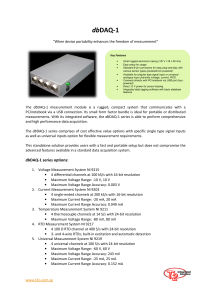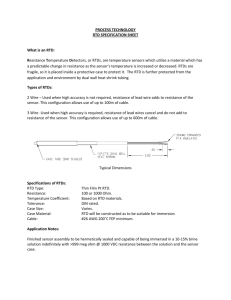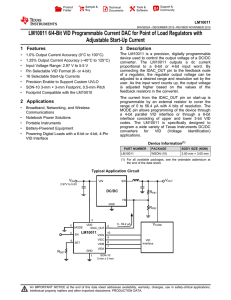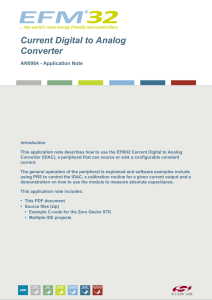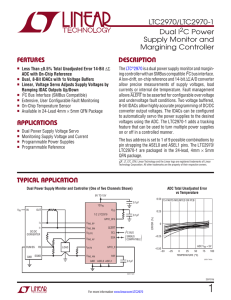2- 3- 4- Wire RDT (Pt100 to PT1000)Temperature Measurement
advertisement
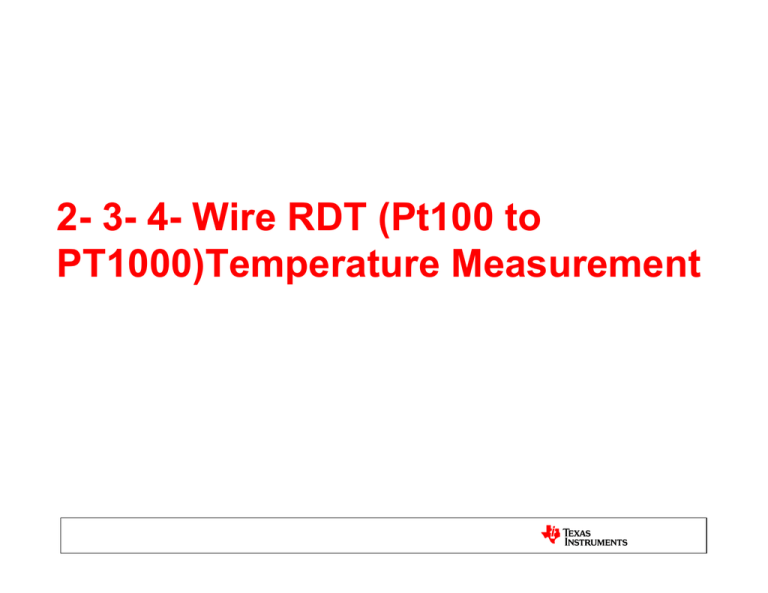
2- 3- 4- Wire RDT (Pt100 to PT1000)Temperature Measurement RTD Sensors most common PT100; PT500; PT1000 • RTD: resistance temperature device • Linear resistance change with temperature • Positive temperature coefficient • Wire-wound or thick film metal resistor Over Limited Temperature Range RTD Sensors Advantages and disadvantages Advantages • Accuracy available to +/-0.1°C • High linearity over limited temperature range; ex. -40°C to +85°C • Wide temperature range: -250°C to 600°C (ASTM) 850°C (IEC) Disadvantages (mostly minor) • Limited resistance range 100Ω to 1kΩ (typically) • Low sensitivity, about +0.4Ω/°C for a 100Ω Pt100 RTD • Requires linearization for wide range; ex. -200°C to +850°C • Lead wire resistance may introduce significant errors • Cost is high compared to a thermistor Up to 10kΩ, Down to 10Ω available But Wider Temperature Range ADS1247/48 24-Bit, Complete Temperature Measurement ADC Device Features: • 2/4 Differential or 3/7 Single-Ended • True Bipolar ± 2.5V or Unipolar 5V • Max Data Rate – 2kSPS • Low Noise PGA: 40nV @ G = 128 • 50/60Hz Simultaneous Rejection Mode (20SPS) On-Chip Integration: • Low Drift Internal Reference (10 ppm/℃ Max) • Dual Matched Current DACs (50 – 1500 μA) • Oscillator, Temp Sensor, Burnout Detect • 4/8 GPIO’s • 16-Bit version: ADS1147/48 coming 2Q’09 • Ultimate Temperature Sensor Measurement Solution • Most Flexible Front End for a Wide Range of Industrial Sensors • High Integration Without Compromising Performance • Scalable Solutions • Temperature Management – RTDs, Thermocouples, Thermistors • Flow/Pressure Measurement • Industrial Process Control EVM ADS1248EVM 20/28-Pin TSSOP ADS1246/47/48 Analog Input Multiplexer Circuit IDAC1 and IDAC2 can be sequently connected to each of the eight input channels and at the same time all these inputs can be sequently connected to the PGA input. This allows to drive the excitation current to one input and measure at the same time the voltage drop on this input. Ratio-Metric 2-Wire RTD application Advantage: •Very simple RTD connection. •IDAC generates the sensor excitation and the reference voltage. •Noise and drift of the Ref voltage are correlated and therefore canceled. •Only one current source no mismatch. •Up to 7 RTDs are possible Disadvantage: Voltage drop across the line resistance. 3-Wire RTD connection Advantage: •IDAC generates the sensor excitation and the reference voltage. •Noise and drift of the ref voltage are correlated and therefore canceled. •Voltage drop across the line resistance are compensated Disadvantage: •Needs two current sources. •Only IDAC current mismatch matters. 3-Wire RTD with compensation Advantage: •IDAC generates the sensor excitation and the reference voltage. •Noise and drift of the Ref voltage are correlated and therefore canceled. •Voltage drop across the line resistance are compensated. •Allows complete utilization of the input range, no offset caused by the RTD itself. Disadvantage: •Needs two current sources. •Only IDAC current mismatch matters. 4-Wire RTD Advantage: •IDAC generates the sensor excitation and the reference voltage. •Noise and drift of the Ref voltage are correlated and therefore canceled. •Voltage drop across the line resistance are compensated. •No IDAC current mismatch because only one current path is needed. Disadvantage: •Four connections are used for every sensor. •Up to 3 RTDs are possible
